Spatial Life Cycle Analysis of Soybean-Based Biodiesel Production in Indiana, USA Using Process Modeling
Abstract
:1. Introduction
2. Materials and Methods
2.1. System and System Boundary
2.2. Regional Life Cycle Inventory for Biodiesel from Soybean in Indiana
2.3. Soybean Farming
2.4. Soybean Biodiesel Production
2.5. Biodiesel Production Process Modeling
2.6. Transportation Life Cycle Stage
3. Allocating Spatial Impacts at County Scale to Soybean Based Biodiesel Production
4. Results and Discussion
4.1. North Indiana
4.2. Central Indiana
5. Conclusions
Supplementary Materials
Author Contributions
Funding
Acknowledgments
Conflicts of Interest
References
- Nitschelm, L.; Aubin, J.; Corson, M.S.; Viaud, V.; Walter, C. Spatial differentiation in Life Cycle Assessment LCA applied to an agricultural territory: Current practices and method development. J. Clean. Prod. 2016, 112, 2472–2484. [Google Scholar] [CrossRef]
- Tilman, D.; Socolow, R.; Foley, J.A.; Hill, J.D.; Larson, E.; Lynd, L.R.; Pacala, S.; Reilly, J.; Searchinger, T.; Somerville, C.; et al. Beneficial Biofuels--The Food, Energy, and Environment Trilemma. Science 2009, 325, 270–271. [Google Scholar] [CrossRef] [PubMed] [Green Version]
- Kim, S.; Dale, B.E. Life cycle assessment of various cropping systems utilized for producing biofuels: Bioethanol and biodiesel. Biomass Bioenergy 2005, 29, 426–439. [Google Scholar] [CrossRef]
- Qin, Z.; Zhuang, Q.; Cai, X.; He, Y.; Huang, Y.; Jiang, N.; Lin, E.; Liu, Y.; Tang, Y.; Wang, M.Q. Biomass and biofuels in China: Toward bioenergy resource potentials and their impacts on the environment. Renew. Sustain. Energy Rev. 2018, 82, 2387–2400. [Google Scholar] [CrossRef]
- Kesieme, U.; Pazouki, K.; Murphy, A.; Chrysanthou, A. Attributional life cycle assessment of biofuels for shipping: Addressing alternative geographical locations and cultivation systems. J. Environ. Manag. 2019, 235, 96–104. [Google Scholar] [CrossRef] [PubMed] [Green Version]
- Chen, J.; Li, J.; Dong, W.; Zhang, X.; Tyagi, R.D.; Drogui, P.; Surampalli, R.Y. The potential of microalgae in biodiesel production. Renew. Sustain. Energy Rev. 2018, 90, 336–346. [Google Scholar] [CrossRef]
- Tsiropoulos, I.; Faaij, A.P.C.; Seabra, J.E.A.; Lundquist, L.; Schenker, U.; Briois, J.-F.; Patel, M.K. Life cycle assessment of sugarcane ethanol production in India in comparison to Brazil. Int. J. Life Cycle Assess. 2014, 19, 1049–1067. [Google Scholar] [CrossRef]
- Reijnders, L.; Huijbregts, M.A.J. Palm oil and the emission of carbon-based greenhouse gases. J. Clean. Prod. 2008, 16, 477–482. [Google Scholar] [CrossRef]
- Castanheira, E.; Grisoli, R.; Coelho, S.; Da Silva, G.A.; Freire, F. Life-cycle assessment of soybean-based biodiesel in Europe: Comparing grain, oil and biodiesel import from Brazil. J. Clean. Prod. 2015, 102, 188–201. [Google Scholar] [CrossRef]
- Rajaeifar, M.A.; Ghobadian, B.; Safa, M.; Heidari, M.D. Energy life-cycle assessment and CO2 emissions analysis of soybean-based biodiesel: A case study. J. Clean. Prod. 2014, 66, 233–241. [Google Scholar] [CrossRef]
- Hiloidhari, M.; Baruah, D.; Singh, A.; Kataki, S.; Medhi, K.; Kumari, S.; Ramachandra, T.V.; Jenkins, B.; Thakur, I.S. Emerging role of Geographical Information System (GIS), Life Cycle Assessment (LCA) and spatial LCA (GIS-LCA) in sustainable bioenergy planning. Bioresour. Technol. 2017, 242, 218–226. [Google Scholar] [CrossRef] [PubMed]
- Tabatabaie, S.M.H.; Tahami, H.; Murthy, G.S. A regional life cycle assessment and economic analysis of camelina biodiesel production in the Pacific Northwestern US. J. Clean. Prod. 2018, 172, 2389–2400. [Google Scholar] [CrossRef]
- Humpenöder, F.; Schaldach, R.; Cikovani, Y.; Schebek, L. Effects of land-use change on the carbon balance of 1st generation biofuels: An analysis for the European Union combining spatial modeling and LCA. Biomass Bioenergy 2013, 56, 166–178. [Google Scholar] [CrossRef]
- Cronin, K.R.; Runge, T.M.; Zhang, X.; Izaurralde, R.C.; Reinemann, D.J.; Sinistore, J.C. Spatially Explicit Life Cycle Analysis of Cellulosic Ethanol Production Scenarios in Southwestern Michigan. BioEnergy Res. 2016, 10, 13–25. [Google Scholar] [CrossRef] [Green Version]
- Butnar, I.; Rodrigo, J.; Gasol, C.M.; Castells, F. Life-cycle assessment of electricity from biomass: Case studies of two biocrops in Spain. Biomass Bioenergy 2010, 34, 1780–1788. [Google Scholar] [CrossRef]
- Patouillard, L.; Bulle, C.; Querleu, C.; Maxime, D.; Osset, P.; Margni, M. Critical review and practical recommendations to integrate the spatial dimension into life cycle assessment. J. Clean. Prod. 2018, 177, 398–412. [Google Scholar] [CrossRef] [Green Version]
- Crops and Plants; USDA-NASS: Washington, DC, USA, 2012. Available online: http://www.nass.usda.gov/ (accessed on 6 May 2013).
- U.S. Energy Information Administration (EIA). Available online: https://www.eia.gov/ (accessed on 26 February 2020).
- Potter, S.R.; Andrews, S.; Atwood, J.D.; Kellogg, R.L.; Lemunyon, J.; Norfleet, L. Model Simulation of Soil Loss, Nutrient Loss, and Change in Soil Organic Carbon Associated with Crop Production; United States Department of Agriculture: Washington, DC, USA, 2006.
- FACT SHEET: Biofuels Plants in Indiana; Indiana State Department of Agriculture: Indianapolis, IN, USA, 2013.
- Lee, K.W.; Yu, J.X.; Mei, J.H.; Yan, L.; Kim, Y.W.; Chung, K.W. A kinetic study on the transesterification of glyceryl monooleate and soybean used frying oil to biodiesel. J. Ind. Eng. Chem. 2007, 13, 799–807. [Google Scholar]
- Alexander, C.; Conley, S.P.; Dobbins, C.; Hurt, C.; Patrick, G. Soybean Production Systems: Where Do Indiana Soybean Producers Sell; Purdue Extension: West Lafayette, IN, USA, 2006. [Google Scholar]
- ISDA: Grain Licensee Listing. Available online: https://www.in.gov/isda/2399.htm (accessed on 30 December 2019).
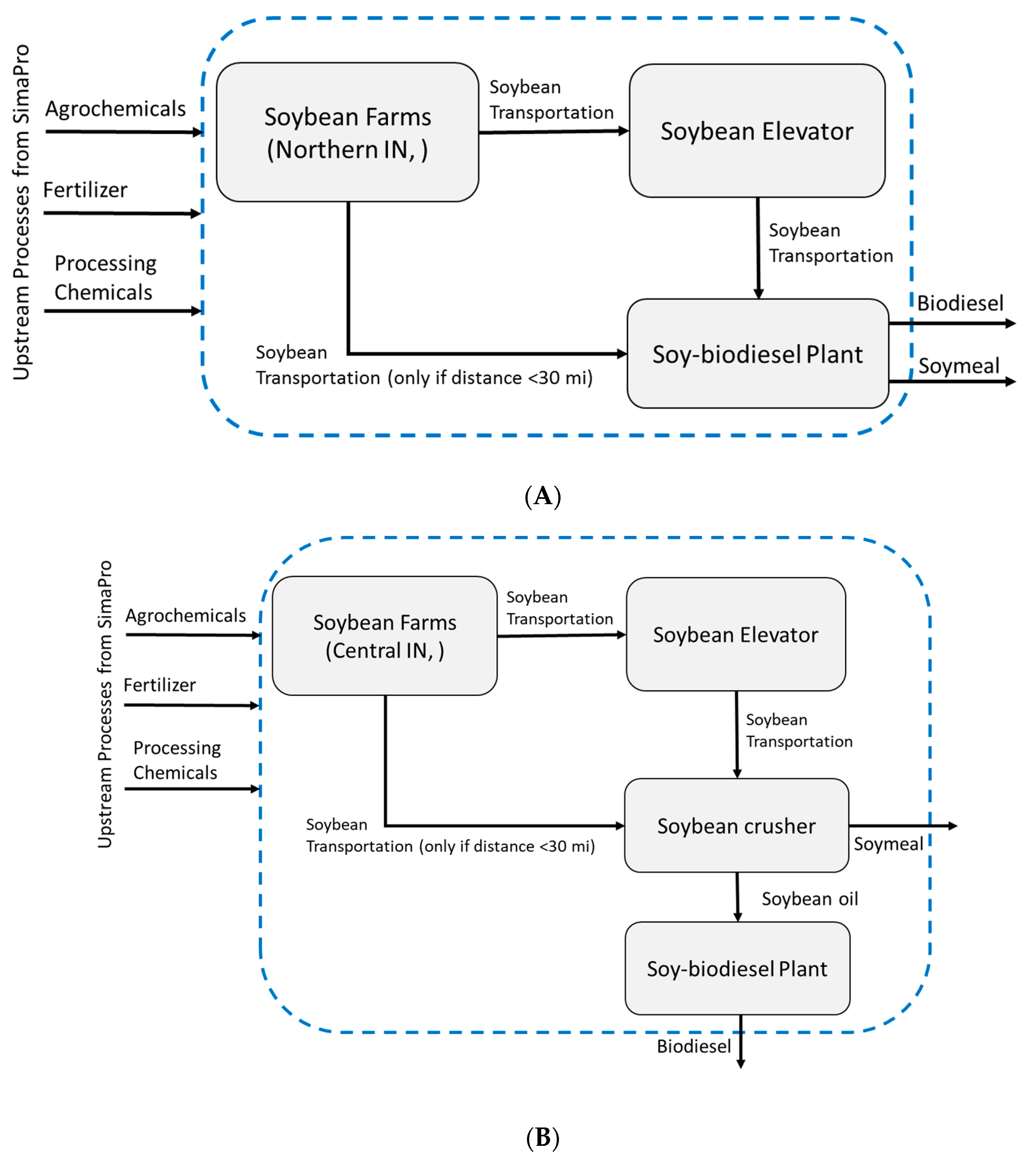
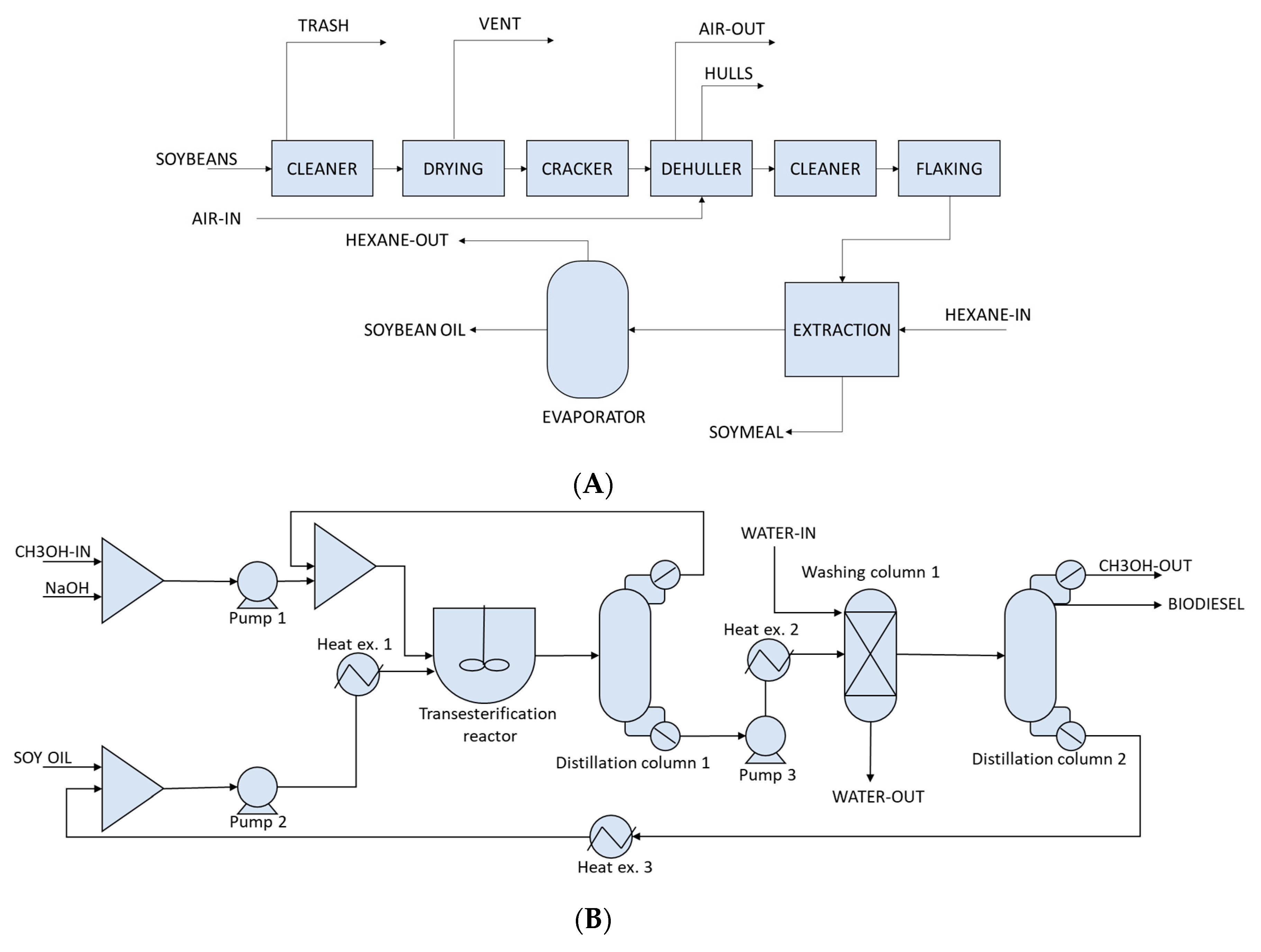
| Location | Plant Capacity | Feedstock |
|---|---|---|
| Claypool, Kosciusko county, Indiana | 99 Mega gallons per year | Soybean |
| Morrisontown, Shelby county, Indiana | 5 Mega gallons per year | Soy-oil |
| Life Cycle Stage | Material Flow | North Indiana | Central Indiana |
|---|---|---|---|
| Soybean farming | Acres of soybean crop harvested—m2 | 5.53 × 109 | 3.08 × 108 |
| Water applied—m3 | 6.75 × 108 | 3.75 × 107 | |
| Soybean—kg | 1.80 × 109 | 9.12 × 107 | |
| Fertilizer applied—N (kg) | 2.84 × 106 | 3.42 × 106 | |
| Bio fixation—N (kg) | 1.51 × 108 | 1.92 × 108 | |
| Fertilizer applied—P2O5 (kg) | 1.72 × 107 | 2.08 × 107 | |
| Fertilizer applied—K2O (kg) | 4.62 × 107 | 5.57 × 107 | |
| N emissions air (kg) | 1.17 × 107 | 1.49 × 107 | |
| N emissions soil (kg) | 3.85 × 106 | 4.91 × 106 | |
| N emissions water (kg) | 1.00 × 107 | 1.28 × 107 | |
| P emissions water (kg) | 1.20 × 106 | 1.53 × 106 | |
| Soybean processing | Soybeans used (kg) | 1.80 × 109 | 9.12 × 107 |
| Sodium hydroxide (kg) | 1.73 × 107 | 8.78 × 105 | |
| Methanol (kg) | 3.49 × 107 | 1.76 × 106 | |
| Hexane (kg) | 3.68 × 108 | 1.86 × 107 | |
| Water (kg) | 1.73 × 107 | 8.78 × 105 |
| Soybean Farming Stage | |
|---|---|
| Water Consumption—Liter Per Liter Biodiesel Produced | |
| Northern Counties | Central Indiana Counties |
 | 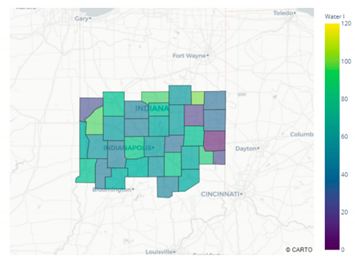 |
| Land use—m2/liter biodiesel produced | |
| Northern Counties | Central Indiana Counties |
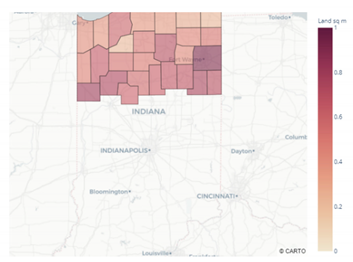 |  |
| Global warming potential—kg CO2 eq per liter biodiesel produced | |
| Northern Counties | Central Indiana Counties |
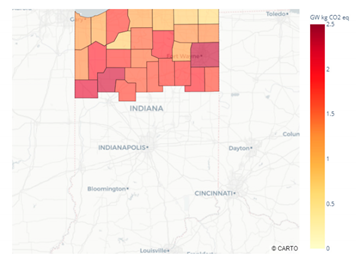 | 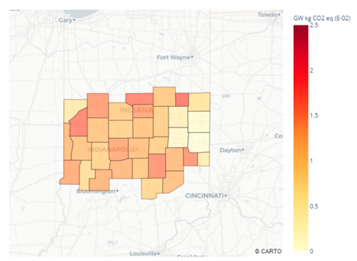 |
| Eutrophication—kg N (10−3) eq per liter biodiesel produced | |
| Northern Counties | Central Indiana Counties |
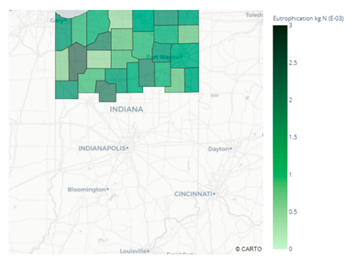 | 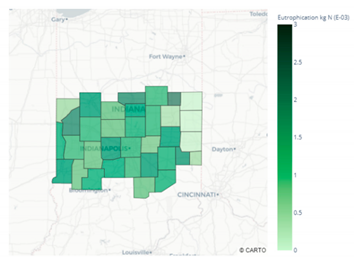 |
| Transportation Stage | |
| Global warming potential—kg CO2 (10−3) eq per liter biodiesel produced | |
| Northern Counties | Central Indiana Counties |
 | 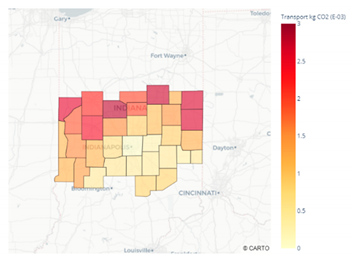 |
| Eutrophication—kg N (10−7) eq per liter biodiesel produced | |
| Northern Counties | Central Indiana Counties |
 | 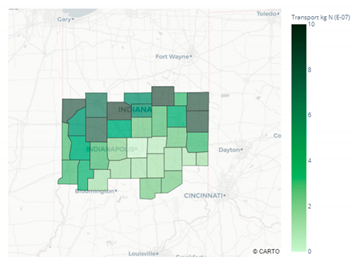 |
| Soybean Biodiesel Production Stage | |
| Northern Production Facility | Central Production Facility |
| Soybean biodiesel production Global warming potential—kg CO2 per liter of biodiesel produced = 0.39 Eutrophication—kg N eq per liter of biodiesel produced = 1.16 × 10−3 | Soybean oil production Global warming potential—kg CO2 per liter biodiesel produced = 0.23 Eutrophication—kg N eq per liter of biodiesel produced = 1.13 × 10−3 |
| Soybean biodiesel production Global warming potential—kg CO2 per liter biodiesel produced = 0.17 Eutrophication—kg N eq per liter of biodiesel produced = 2.54 × 10−5 | |
© 2020 by the authors. Licensee MDPI, Basel, Switzerland. This article is an open access article distributed under the terms and conditions of the Creative Commons Attribution (CC BY) license (http://creativecommons.org/licenses/by/4.0/).
Share and Cite
Vunnava, V.S.G.; Singh, S. Spatial Life Cycle Analysis of Soybean-Based Biodiesel Production in Indiana, USA Using Process Modeling. Processes 2020, 8, 392. https://doi.org/10.3390/pr8040392
Vunnava VSG, Singh S. Spatial Life Cycle Analysis of Soybean-Based Biodiesel Production in Indiana, USA Using Process Modeling. Processes. 2020; 8(4):392. https://doi.org/10.3390/pr8040392
Chicago/Turabian StyleVunnava, Venkata Sai Gargeya, and Shweta Singh. 2020. "Spatial Life Cycle Analysis of Soybean-Based Biodiesel Production in Indiana, USA Using Process Modeling" Processes 8, no. 4: 392. https://doi.org/10.3390/pr8040392
APA StyleVunnava, V. S. G., & Singh, S. (2020). Spatial Life Cycle Analysis of Soybean-Based Biodiesel Production in Indiana, USA Using Process Modeling. Processes, 8(4), 392. https://doi.org/10.3390/pr8040392






